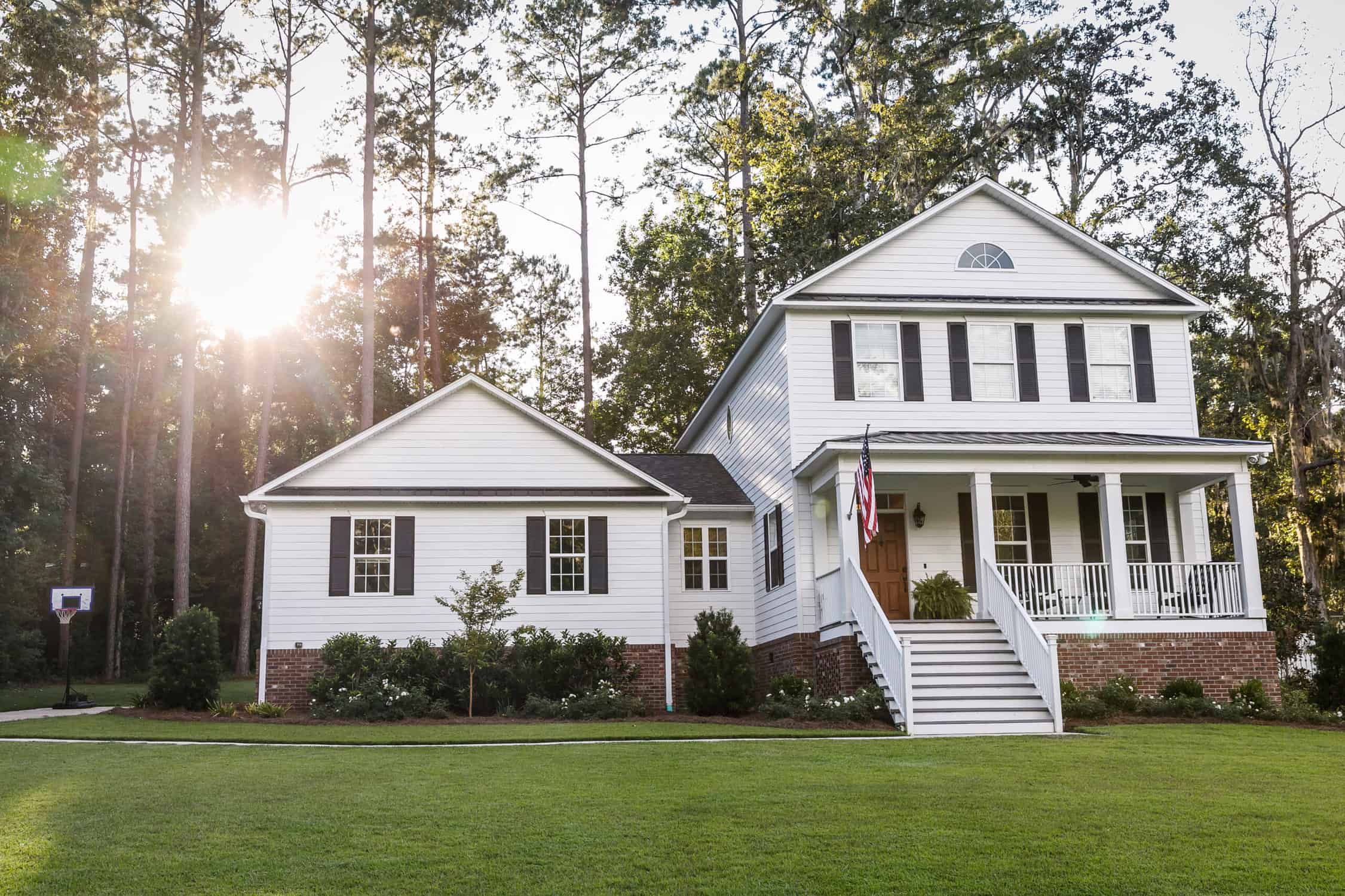When it comes to protecting and beautifying wood siding, one of the most common debates among property owners is: Should you use exterior paint or stain?
Both options offer weather protection and aesthetic enhancement, but they do so in very different ways. Paint forms a solid film that acts as a physical barrier against moisture, UV rays, and physical wear. It can dramatically transform the look of a structure but may eventually crack or peel if not properly applied. Stain, on the other hand, penetrates the wood, emphasizing its natural grain and texture while offering breathable protection. It’s more subtle in appearance and easier to maintain—but it generally needs more frequent reapplication.
So, how do you choose between paint and stain for your wood siding?
This guide breaks down the science behind both coatings, their pros and cons, and how they perform on different wood types in various climates.
Understanding Wood Siding and Its Vulnerabilities
Types of Wood Siding
Wood siding comes in many forms, each with its own structure and finish compatibility:
-
Clapboard and Shiplap: Horizontal boards; vary in porosity
-
Board-and-Batten: Vertical boards with seams; more prone to water intrusion
-
Wood Shingles: Often cedar; typically stained to retain texture
-
Engineered Wood: Manufactured for uniformity; sometimes pre-primed
Grain density and absorbency vary significantly between softwoods (like pine or cedar) and hardwoods (like cypress or oak), which impacts how coatings perform.
Common Threats to Wood Siding
Wood is a natural, porous material, vulnerable to multiple environmental stressors:
-
Moisture intrusion can cause rot, swelling, and cracking
-
UV exposure breaks down lignin, causing fading and brittleness
-
Fungi and mold thrive on damp wood surfaces
-
Temperature swings and physical wear can cause checking, warping, or splitting
Role of Exterior Coatings
Paint and stain both aim to do the following:
-
Repel moisture to prevent swelling and rot
-
Protect against UV rays to minimize degradation and fading
-
Enhance appearance, whether by transforming or showcasing the wood’s texture
Properly chosen and applied, both can dramatically extend the life and appearance of wood siding.
Chemistry and Composition Differences: Paint vs. Stain
Understanding the materials behind each coating system is key to making an informed decision.
Exterior Paint
Paint is a film-forming product that sits atop the wood surface, creating a continuous barrier.
Main Components:
-
Pigments for color and UV blocking
-
Binders (usually 100% acrylic for exteriors) for film formation and adhesion
-
Solvents (mostly water in modern products)
-
Additives for mildew resistance, viscosity control, etc.
Characteristics:
-
Completely opaque—hides wood grain and knots
-
Builds a thick film—typically 4–6 mils (wet) per coat
-
Highly customizable in color and finish
Common Products:
-
Benjamin Moore Aura® Exterior Paint
-
Behr Premium Plus Ultra Exterior
Paint provides the most comprehensive UV and moisture protection, especially when paired with the right primer.
Exterior Stain
Stain penetrates the wood’s surface instead of forming a thick film.
Main Components:
-
Pigments or dyes for color and UV resistance
-
Oils or resins for penetration and adhesion
-
Solvents (mineral spirits or water-based carriers)
-
Mildewcides and water repellents
Stain Types:
-
Transparent: Enhances wood grain; minimal protection
-
Semi-transparent: Some pigment for UV defense; shows grain
-
Solid: Almost paint-like appearance but thinner film
Common Products:
-
Cabot Semi-Transparent Exterior Stain
-
Behr Premium Semi-Transparent Waterproofing Stain
-
Sikkens Cetol SRD
Stain creates a breathable surface that won’t crack or peel, making touch-ups easier but requiring more frequent maintenance.
Performance Differences on Wood Siding
Let’s break down the technical performance aspects that matter most.
Moisture Protection
Paint offers a watertight seal. It blocks moisture entirely—great for protecting softwoods and preventing deep water ingress. However, if moisture gets trapped beneath the film (due to poor prep or damp wood), the result is peeling or blistering.
Stain, especially semi-transparent and transparent types, allows wood to breathe. It repels water while reducing the risk of trapped moisture, making it suitable for damp or shaded areas.
UV and Color Retention
Paint blocks nearly 100% of UV rays thanks to its pigment density. It resists sun-induced fading much longer than stain and maintains bold color for years.
Stain’s UV resistance depends on pigment load. Transparent stains offer minimal protection, while solid stains perform closer to paint but still fade over time—often more gradually and evenly.
Flexibility and Cracking
Paint is less forgiving. It forms a rigid film that may crack or peel as the wood moves with humidity and temperature shifts.
Stain is more flexible. Because it penetrates, it moves with the wood, reducing cracking risk—especially in semi-transparent formulations.
Maintenance and Longevity
| Performance Factor | Paint | Stain |
|---|---|---|
| Lifespan | 7–15 years (climate-dependent) | 2–5 years (type-dependent) |
| Ease of Repair | Labor-intensive | Simple touch-ups possible |
| Maintenance Frequency | Lower | Higher |
| Peeling Risk | Higher (if film fails) | Lower (absorbs into surface) |
Paint generally lasts longer between recoats but can be more difficult and costly to fix once it fails. Stain wears away gently and can be re-applied with minimal prep.
Aesthetic Considerations
Paint offers:
-
Unlimited color options
-
Consistent, smooth finishes
-
Full coverage of blemishes or discoloration
Stain allows:
-
Natural grain visibility
-
Rich, warm tones that enhance character
-
Subtle aging over time
Product Recommendations for Different Wood Types and Climates
Softwoods in Humid Climates (e.g., Pine, Cedar in the Pacific Northwest)
These woods are porous and vulnerable to rot. Moisture and mold are key concerns.
-
Use solid or semi-transparent stains with added mildewcides (e.g., Sikkens Cetol SRD)
-
Choose flexible acrylic paints like Sherwin-Williams Duration® for better crack resistance
Hardwoods in Dry Climates (e.g., Oak, Cypress in Arizona)
Hardwoods are more stable but still susceptible to sun damage.
-
Use semi-transparent stains to showcase grain and provide UV protection
-
High-quality paints like Benjamin Moore Aura® retain color and resist chalking in intense sun
Engineered or Composite Wood Siding
Typically uniform, smoother, and pre-treated.
-
Paint is usually preferred for adhesion and coverage
-
Use stain only if manufacturer-approved (check warranty terms)
Coastal Areas (e.g., Florida, Gulf Coast)
Salt, humidity, and intense sun create a hostile environment.
-
Look for elastomeric paints or stains with salt spray resistance
-
Ensure coatings include advanced mildew inhibitors
| Wood Type | Climate | Best Finish | Example Products |
|---|---|---|---|
| Cedar (softwood) | Humid | Semi-trans. stain | Sikkens Cetol SRD, Behr Premium Stain |
| Oak (hardwood) | Dry/Sunny | Semi-trans. stain/paint | Aura Exterior, Cabot Semi-Transparent |
| Composite board | Any | Paint | Behr Ultra Exterior, Sherwin-Williams Emerald |
| Cypress (hard) | Humid/Coastal | Paint w/ mildew block | Duration® Exterior, Benjamin Moore Element Guard |
Service-Specific Preparation and Application Tips

Beautiful windows with shutters and plants to welcome any visitor
Surface Preparation
No coating lasts without a properly prepped surface. Here’s what professional painters prioritize:
-
Clean with mild detergent or TSP substitute
-
Remove peeling paint or failing stain with a scraper or sander
-
Ensure wood has 12–15% or lower moisture content (use a moisture meter)
Priming (for Paint Only)
Unprimed or bare wood should be sealed with a high-quality wood primer to:
-
Improve adhesion
-
Block tannin bleed (especially with cedar or redwood)
-
Reduce topcoat absorption
Use stain-blocking acrylic primers or alkyd-based primers for tannin-heavy species.
Application Best Practices
-
Brushes and rollers for paint; brushes or sprayers for stain
-
Work in shaded, dry conditions between 50°F–85°F
-
Apply thin, even coats to avoid drips or blotching
-
Avoid painting right before rain or in direct sun
Post-Application Maintenance
-
Inspect annually for peeling or mildew
-
Wash gently with low-pressure water or a soft brush
-
Recoat based on visual signs of wear—not just by schedule
Addressing Common Concerns and Myths
“Paint Traps Moisture, Leading to Rot”
This is only true if the wood was painted while still damp or if the paint film was compromised. Proper prep, priming, and drying prevent this issue.
“Stain Is Easier and Cheaper”
Initial application might be cheaper, but the frequent recoats can add up. Over 15 years, paint may be more economical, especially with quality prep and products.
“You Can Switch Between Paint and Stain Anytime”
Not quite. Transitioning requires extensive surface prep:
-
Paint over stain needs cleaning, sanding, and priming
-
Stain over paint is not recommended unless the paint is fully removed
People Also Ask (FAQs)
Q1: Can I paint over stained wood siding?
A: Yes, but proper prep is essential. Clean, sand to de-gloss, and apply a compatible primer to ensure the paint adheres.
Q2: How often should I re-stain wood siding?
A: Every 2–5 years depending on the stain type, sun exposure, and humidity. Transparent stains need the most frequent touch-ups.
Q3: Which lasts longer on wood siding—paint or stain?
A: Paint lasts longer (up to 15 years), while stain offers easier reapplication but needs more frequent attention.
Q4: Does paint or stain protect better against UV damage?
A: Paint, due to its opacity and pigment load, offers superior UV resistance. Solid stains come close; transparent stains protect the least.
Q5: Will paint hide wood siding imperfections better than stain?
A: Absolutely. Paint conceals discoloration, knots, and irregular grain. Stain highlights these features.
Know Your Goals, Wood Type, and Climate
Choosing between paint and stain for wood siding isn’t just an aesthetic decision—it’s a matter of performance, longevity, and environmental compatibility.
-
Want long-term color stability and full coverage? Go with exterior-grade paint.
-
Prefer a natural look and breathable surface? Choose a high-quality stain, ideally semi-transparent for balance.
Each system requires proper prep, the right product, and mindful application.
Need help evaluating your wood siding? Contact LiteHouse Painting today for a free coating consultation. Our team will assess your wood siding’s condition, climate risks, and design goals to help you select and apply the best protective finish—professionally and efficiently.




